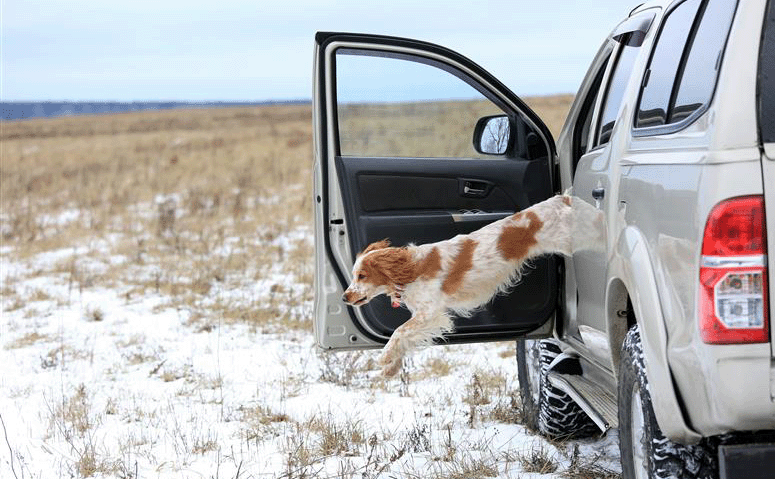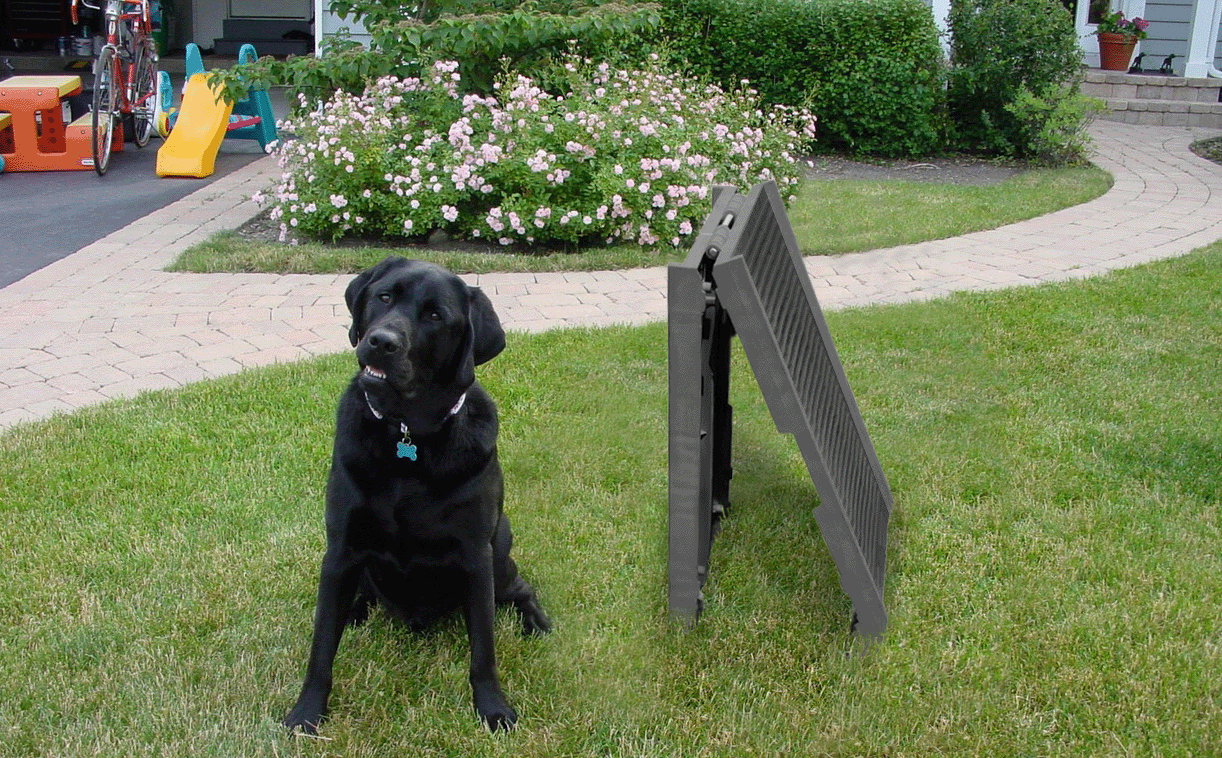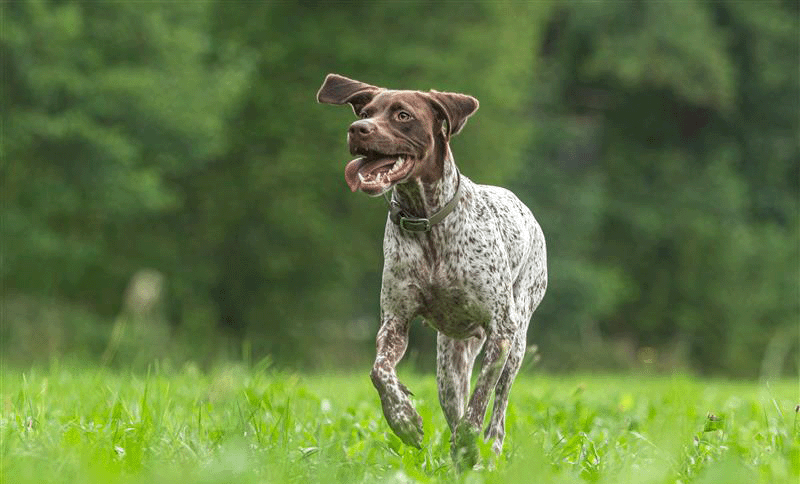-
- SHOP
- Pool Ramp for Dogs
- For People
- For Pets
- Gallery
- Blog
- Our Company
- Cart
- Login
- Newsletter
- Free US Shipping on orders over $79!
Hunting dogs play an essential role in the field, assisting hunters with both tracking and retrieving. Their skills and instincts make them invaluable companions during hunts, but the physical demands placed on them can take a toll. One common practice among hunters is having their dogs jump on and off the back of trucks before and after a hunt. While this may seem like a quick and convenient action, it can actually lead to long-term harm to a dog’s joints and overall health. In this blog, we’ll explore the risks associated with jumping into and out of the back of a truck and explain why using a dog ramp is a safer, more beneficial alternative to keep your dog in good health for years to come.
The bed of a typical full-sized truck is 35” to 45” off the ground. Jumping the tail can put significant strain on a dog’s joints, particularly in the elbows, knees, hips, and spine. Each time a dog leaps down from a height, the impact on their body is similar to a heavy force being absorbed by their legs and joints. Over time, this repetitive motion can lead to joint stress, wear, and even injuries.
Dogs, especially those involved in hunting, tend to be very active and often subjected to these types of movements multiple times in a single outing. For dogs that are regularly jumping down from trucks, the repeated impact can significantly increase the risk of long-term joint issues, such as arthritis, tendonitis, and hip or elbow dysplasia, making it harder for them to stay active and perform in the field. Not to mention, seeing your dog in pain is always a heartbreaking experience.
This risk of jumping injuries is even more pronounced in breeds that are genetically predisposed to joint problems, such as hip dysplasia. Breeds like Golden Retrievers and Labradors, popular hunting dogs, are more likely to develop hip or elbow dysplasia due to their anatomical structure. For these dogs, the stress caused by frequent jumping can exacerbate these conditions, leading to early-onset arthritis and other mobility issues. Even dogs without pre-existing joint conditions can experience wear and tear from the repetitive impact of jumping, reducing their quality of life and limiting their ability to participate in future hunts.
In fact, there is a condition coined after an injury dogs can experience after repetitive jumping called Jump Down Syndrome. Jump Down Syndrome, or JDS, affects the elbow joint, where a small piece of bone can fracture and separate, causing pain and lameness in the leg. The repeated stress of jumping to and from a height has been recognized by vets as a significant cause of this condition. And unlike joint conditions that affect certain ages or breeds, JDS can affect dogs of any breed or age–so any pup jumping in and out of a truck is at risk.
When we were consulting with an orthopedic specialist about Nate’s shoulder/elbow issues a year or so ago, she told us about what they have come to coin as “jump down” syndrome – hunting/field dogs that have spent years jumping off of tailgates (or out of dog trucks).
Over time it wreaks havoc mostly on the elbows, some on the shoulders – but overall it’s incredibly detrimental to their joint well-being. Especially if this starts when the dogs are quite young and the bones/joints not completely formed.
We were somewhat diligent about getting the dogs in and out of the truck back then, but now we are much more aware.
– “Lydia,” via RetrieverTraining.net

Over time, the repetitive impact of jumping in and out of a truck can contribute to cumulative damage, leading to chronic conditions such as arthritis, joint instability, and ligament injuries. The force of landing, especially on hard surfaces, puts excessive strain on the elbows, shoulders, and hind legs, increasing the risk of cartilage wear and painful inflammation. As dogs age, their ability to absorb this shock diminishes, resulting in stiffness, reduced mobility, and a higher likelihood of developing degenerative joint disease. What may seem like an effortless movement in a young, energetic dog can have lasting consequences that affect their quality of life later on.
We learned the hard way, our last labs lived to be 14 and 15 years old. After they were grown, they were allowed to jump into and out of our trucks. They both developed pinch nerve symptoms in their older years which at times had to be treated with steroids and pain meds.
– “Paula” via RetrieverTraining.net
For older or previously injured dogs, the toll of frequent jumping can be even more severe. Dogs already suffering from arthritis, hip dysplasia, or past ligament injuries may experience worsening pain and decreased range of motion due to the repeated impact. The strain can also accelerate the progression of existing joint conditions, making daily activities more difficult and painful. To prevent long-term harm, using a dog ramp will help minimize stress on the joints and provide a safer, low-impact way for your dog to enter and exit your truck. Taking proactive measures early on can help preserve your dog’s mobility, comfort, and overall well-being as they age.

As discussed in the previous sections, getting in and out of a truck is a frequent part of a hunting dog’s job, but repeatedly jumping can take a toll on their bodies over time. While some dogs may seem agile enough to handle the leap, the impact of landing can lead to joint strain, muscle fatigue, and even injuries. A dog ramp offers a safer, more practical alternative by providing a controlled and gentle way for your dog to access your truck. Not only does it protect their long-term health, but it also enhances safety, convenience, and ease of use for both you and your dog.
Since repeated jumping can put significant strain on a dog’s joints and muscles, a dog ramp offers a smooth and gradual incline, allowing dogs to enter and exit the truck without the jarring impact of a jump. This low-impact transition helps maintain their joint health, ensuring they remain agile and comfortable throughout their hunting years.
Beyond joint protection, dog ramps also greatly improve safety by eliminating the risk of slips, falls, or missed jumps that could result in injuries. This is particularly crucial for older dogs or those recovering from past injuries, as they may struggle with the coordination and strength required to jump safely. Additionally, a dog ramp with a non-slip surface will also ensure that your pup will be able to step securely and safely in slippery weather conditions like rain, mud, and snow.
[Not using a dog ramp] is a silly expensive risk to take once you know the potential hazards. When my older dog was a pup, we let her jump into the bed of the pick-up on a regular basis (twice per week). At the age of 4, she tore out her knee due to the springing motion of jumping up and in. Surgery cost was $3,600. That was 6 years ago, so I bet the price tag is even higher now.
As for jumping down, the impact on the elbows and shoulders is huge (if jumping from the bed of the pick-up). If the dog doesn’t get an injury, you can bet she’ll be rickety in her old age.
– “Jennifer Henion” via RetrieverTraining.net
Dog ramps also provide greater convenience and control for owners, allowing you to guide your dog’s movement with ease. Instead of risking your dog’s joint health by jumping, or your own health by lifting them, a dog ramp makes entry and exit a breeze. If your ramp is foldable, it’ll be easy to store and deploy, making it convenient for consistent use.

If you’ve gotten to this point in the blog, you’re thinking a dog ramp may be a great investment to protect your dog’s joints when jumping in and out of your truck. However, selecting the right ramp requires some careful consideration of various factors to ensure safety, comfort, and convenience. Here are the key elements to keep in mind when choosing the best dog ramp for your pup:

While you may be considering purchasing a dog ramp for hunting trips with your dog, the ramp’s benefits extend far beyond just this activity.
Whether it’s to and from your truck for hunting, up and down from the bed, or in and out of another vehicle, as we’ve discussed at the beginning of this blog, repetitive jumping can severely impact your pup’s joints. In everyday life, a dog ramp can be an invaluable tool for helping your pup access cars, couches, beds, or even stairs with ease. By preventing repetitive jumping in everyday life, you’re preventing potential joint issues and pain.
Beyond everyday use and convenience, using a ramp regularly can have significant long-term health benefits for your dog. Active dogs, like your hunting dog, are more susceptible to joint issues in later life like arthritis, spine issues, and hip and elbow dysplasia. By using a ramp, hunting dogs experience less wear and tear on their bodies, helping to preserve their mobility and overall physical condition as they age. This is particularly important for dogs that are very active beyond just hunting trips.
Consistently using a ramp also supports muscle preservation by allowing your dog to move in a controlled and stable manner rather than relying on forceful leaps. This gradual, low-impact movement is especially beneficial for older hunting dogs or those recovering from injuries, ensuring they can continue performing at their best for years to come.
While your dog may successfully jump in and out of your truck without a care in the world right now, you never know when a jump can turn into an injury. In those cases, prevention of an injury is always less painful (and less expensive) than treatment. Repeated jumping over time can lead to pain, stiffness, and mobility issues, making it harder for your pup to enjoy the activities they love. By preventing joint strain with a ramp, your pup can remain active, happy, and ready for the hunt without unnecessary discomfort or injury.

Hunting dogs are hardworking, energetic, and always eager to perform, but the repeated impact of jumping on and off a truck can take a serious toll on their joints and overall health. Over time, this strain can lead to painful conditions like arthritis, hip dysplasia, or even serious injuries that could cut their hunting careers short. Preventing these risks is essential to keeping your dog in peak condition for years to come.
Investing in a quality dog ramp is a simple yet effective way to enhance your dog’s safety, reduce the risk of injury, and promote long-term mobility. Whether on hunting trips or in everyday situations, a ramp provides a stable, joint-friendly way for your dog to access elevated surfaces with ease. Prioritize your dog’s well-being by making this small but impactful change—because a healthy, happy hunting companion is the best partner you could ask for. Take the next step today and find the right ramp for your loyal companion!